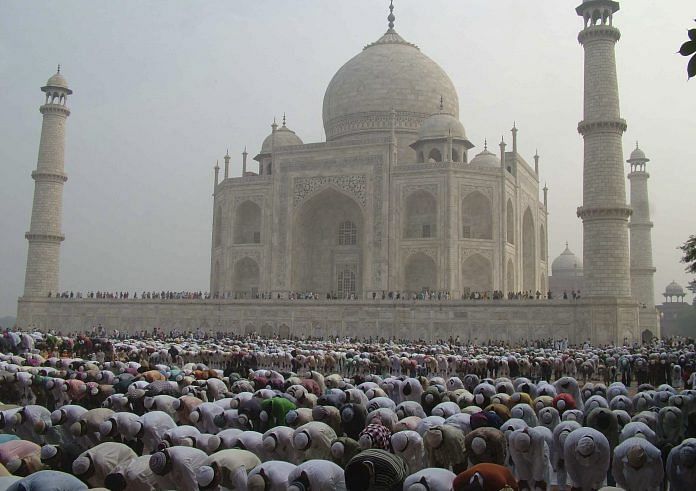It is possible for the Hindutva elites to make use of the favourable passages of the judgment for its anti-Muslim politics.
The Supreme Court ruled Monday that only Agra residents can offer Friday namaz at the mosque situated inside the Taj Mahal.
On the face of it, the ruling clarifies the legal status of the mosque, which is also protected as a historical monument.
However, at another level, the judgment could be selectively used by the Hindutva forces to target Muslims, and question their right to worship.
What’s the case all about?
In January, the authorities started asking visitors to carry an ID to ensure that only locals go inside the mosque to offer namaz.
According to the district administration, several “Bangladeshis and non-Indians” were entering the premises on the pretext of offering namaz on Fridays when the monument remains closed for tourists. A petition was filed in the Supreme Court against this order.
The Supreme Court justified the administrative move by underlining the basic objective of preservation: the protection of the buildings in the Taj Mahal complex, including the mosque.
Since namaz as a religious activity is in consonance with the religious character of the building, the Archaeological Survey of India (ASI) as per the 1958 law allows Muslims to use the space for worship as well. This is why the mosque inside the Taj Mahal remains open from sunrise to sunset.
However, the religious activity may also be regulated as per the norms of the ASI. In that sense, the SC is absolutely right in upholding the order of the local administration.
After all, offering namaz inside the Taj mosque cannot be called the ‘essential practice’ of Islam, and non-Indian Muslim visitors are free to go to a number of other mosques in Agra every Friday.
The two contested questions
This straightforward legal explanation, however, raises two direct political questions.
- Why the distinction between local Muslims and outsiders?
- Is the ‘timing’ of the judgment political?
The distinction between local Muslims and outsiders is the first issue of dispute.
Local Muslims, who carry an ID, are considered legitimate worshippers whose namaz may well be regulated as per the law. On the other hand, the outsiders, which include Indian citizens who do not reside in Agra, “the Bangladeshis and non-Indians”, are seen as trouble-makers. Their right to worship is certainly questioned by evoking security concerns.
This distinction between legitimate and illegitimate worshippers corresponds to the established political rhetoric that Islamic belief, texts and practices could be used by Muslim anti-nationals. Hence, it is suggested that Muslim religious practices in India should be regulated, and if possible, Indianised.
The famous Quran case of the 1980s is a good example in this regard. In 1985, a writ petition was filed in the Calcutta high court demanding that certain ‘objectionable’ verses of the Quran should be removed (Writ Petition 227 of 1985). Although the petition was dismissed by the court on the ground that Quran was the basic text of Islam, Hindu fundamentalist groups still use this case to demand “adequate monitoring” of Muslims and “proper tempering” of Islam.
The ‘timing’ of this judgment also makes it politically contested. In recent years, the Islamic congregational prayers are envisaged as a ‘law and order’ problem, especially in BJP-ruled Uttar Pradesh and Haryana. UP chief minister Yogi Adityanath has categorically said that if Muslims are allowed to offer namaz on streets, there is no harm in celebrating Janmashtami in police stations.
The Haryana chief minister has gone a step further. Instead of taking any action against those who forcibly stopped Muslims from offering namaz in open areas in Gurugram, Manohar Lal Khattar ‘advised’ Muslims to offers prayers only inside the mosques! The order of the district administration to open the Taj mosque for restricted prayers fits well with the present anti-Muslim, anti-namaz rhetoric.
I do not wish to suggest that the Supreme Court ruling is politically motivated. The court, in this case, seems to offer a nuanced interpretation of the local administration’s order.
But, this logical reading of the court order is very different from the popular perceptions of Muslims and the religious practices associated with them. The Hindutva forces have certainly succeeded in communalising the everyday life to such an extent that even the lynching of innocent Muslims is normalised. In such a scenario, it is possible for the Hindutva elites to make use of the favourable passages of the judgment for its anti-Muslim politics.
It is worth noting that the Sachar Commission Report in its recommendations asked the state to clarify the wakf status of the historical mosques, which are functional and protected by the ASI so that the contours of the right to worship be properly defined. Since the state (UPA 1, 2 as well as the present government) has not shown any interest in this question, the politics over namaz inside this historic mosque is likely to survive beyond 2019.
Hilal Ahmed is an associate professor, Centre for the Study of Developing Societies.




I feel this is among the most important info for me.
And i’m glad reading your article. However want to commentary on few general issues,
The site style is wonderful, the articles is really excellent :
D. Just right process, cheers